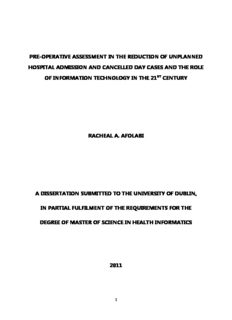
pre-operative assessment in the reduction of unplanned hospital admission and cancelled day ... PDF
Preview pre-operative assessment in the reduction of unplanned hospital admission and cancelled day ...
PRE-OPERATIVE ASSESSMENT IN THE REDUCTION OF UNPLANNED HOSPITAL ADMISSION AND CANCELLED DAY CASES AND THE ROLE OF INFORMATION TECHNOLOGY IN THE 21ST CENTURY RACHEAL A. AFOLABI A DISSERTATION SUBMITTED TO THE UNIVERSITY OF DUBLIN, IN PARTIAL FULFILMENT OF THE REQUIREMENTS FOR THE DEGREE OF MASTER OF SCIENCE IN HEALTH INFORMATICS 2011 1 Declaration I declare that the work described in this dissertation is, except where otherwise stated, entirely my own work, and has not been submitted as an exercise for a degree at this or any other university. Signed: __________________________________________ Date: ____________________________________________ 2 Permission to lend and/or copy I agree that Trinity College Library may lend or copy this dissertation upon request Signed__________________________________ Date____________________________________ 3 Acknowledgements My gratitude goes to God who has enabled me to start and finish this course. Thanks to my darling husband Abimbola for his patience and encouragement; even when I doubted myself for believing in me. To my children Anto, Alex, Andrew and Andrea for supporting me in their own way. To my technical gurus AJ, Zein and Serge for guiding me through the ―hard stuff‖. To N Al-Mane and K Foley for proof reading the document. Thanks to the course coordinator Dr Lucy Hederman for giving me the opportunity to do the course. Thanks to my supervisor Mary Sharp, for her guidance and support. To my colleagues at work for allowing me to be off every Friday, especially Yvonne for ―organising‖ the rota. And finally to all my course mates for continuous inspiration, such a great Bunch to have been with! 4 TABLE OF CONTENTS Declaration................................................................................................ii Permission to lend and/or copy.................................................................iii Acknowledgements......................................................................................iv Chapter 1…………………………………………………………………………………1 1.1 Introduction…………………………………………………………………………………….1 Background & Motivation………………………………………………………………………………………….1 1.3 The Research Question……………………………………………………………………………………………...2 1.4 Overview of the Dissertation……………………………………………………………………………………..2 Chapter 2…………………………………………………………………………………3 Literature Review 2.1 Introduction……………………………………………………………………………………………………………...3 2.2 Databases searched…………………………………………………………………………………………………..4 2.3 Terms used for searches……………………………………………………………………………………………4 2.4 Results of searches…………………………………………………………………………………………………….5 2.5 Pre operative assessment, Day Surgery & Cancellation…………………………………………….5 2.6 Unplanned admission after Day Surgery…………………………………………………………………13 2.7 The Role of IT in Pre operative assessment……………………………………………………………..15 2.8 Conclusion……………………………………………………………………………………………………………….20 Chapter 3……………………………………………………………………………….22 Information Technology in Health 3.1 Health Information Technology in Ireland-Where We Are 5 Past, Present, Future…………………………………………………………………………………………………22 3.2 Benefits/Effects of Information Technology…………………………………………………………….26 3.3 Barriers to Adoption of Information Technology…………………………………………………….28 3.4 Related Technologies………………………………………………………………………………………………28 3.4.1 CDSS…………………………………………………………………………………………………………………..29 3.4.2 CPOE…………………………………………………………………………………………………………………..31 3.4.3 Pharmacy Automation/Bar Coding…………………………………………………………………….32 3.4.4 Telemedicine Systems………………………………………………………………………………………..33 3.4.5 Electronic Health Record…………………………......…………………………………………………….36 3.4.6 PACS.................……………………………………………………………………………………………………..38 3.4.7 RFID……………………………………………………………………………………………………………………39 3.5 Summary…………………………………………………………………………………………..41 Chapter 4……………………………………………………………………………….43 4.1 Introduction…………………………………………………………………………………………………………….43 4.2 Definition of Pre Operative Assessment………………………………………………………………….43 4.3 Pre Operative Assessment……………………………………………………………………………………….44 4.3.1 Guidelines for Pre Operative Assessment………………………………………………………...49 4.4 Day Surgery……………………………………………………………………………………………………………..50 4.4.1 Definition of Day Surgery………………………………………………………………………………….50 4.4.2 Benefits of Day Surgery……………………………………………………………………………………..50 4.4.3 Selection Criteria for Day Surgery……………………………………………………………………..51 Chapter 5……………………………………………………………………………….53 5.1 Introduction……………………………………………………………………...53 5.2 Cancellation of Elective Surgical Cases……………………………………………………………………53 5.3 Unanticipated Hospital Admission………………………………………………………………………….55 6 5.3.1 Definition of Unanticipated Hospital Admission……………………………………………….55 5.4 Causes of Unanticipated Hospital Admission………………………………………………………….55 5.5 Disadvantages of Unanticipated Hospital Admission……………………………………………..56 5.6 Consequences of Hospital Admission ……………………………………………………………………..57 5.6.1 Costs…………………………………………………………………………………………………………………..57 5.6.2Bed Occupancy…………………………………………………………………………………………………..58 5.6.3AdverseEvents…………………………………………………………………………………………………...59 5.6.3.1 Medication Errors………………………………………………………………………………………….59 5.6.3.2 Adverse Drug Reactions………………………………………………………………………………..61 5.6.3.3 Transfusion Errors (Iatrogenic Illness)……………………………………………………………62 5.6.3.4 Hospital Acquired Infection…………………………………………………………………………..63 5.6.3.5 Wrong Patient Identification…………………………………………………………………………63 5.6.3.6 Falls……………………………………………………………………………………………………………….64 5.7 Summary…………………………………………………………………………………………………………………64 Chapter 6……………………………………………………………………………….65 Research 6.1 Introduction…………………………………………………………………………………………………………….65 6.2 Aims of the Research……………………………………………………………………………………………….65 6.3 Approach/Methodology………………………………………………………………………………………….66 6.4 Results……………………………………………………………………………………………………………………..69 6.5 Analysis of the Results…………………………………………………………………………………………….73 6.5.1 Unplanned admission.……………………………………………………………………..........................73 6.5.2 Cancellation………………………………………………………………………………………………………..75 6.5.3 Selection criteria…………………………………………………………………………………………………76 6.6 Summary…………………………………………………………………………………………………………………77 Chapter 7……………………………………………………………………………….78 7 Electronic Pre operative Assessment 7.1 Prototype of Electronic Pre-operative Assessment…………………………………………………78 7.1.1 Introduction………………………………………………………………………………………………………78 7.2 Stake holders…………………………………………………………………………………………………………..78 7.3 End Users…………………………………………………………………………………………………………………78 7.4 Design……………………………………………………………………………………………………………………..79 7.5 Limitation and Difficulties………………………………………………………………………………………..86 7.6 Application and Recommendation………………………………………………………………………….87 7.7 Conclusion and Future Work…………………………………………………………………………………..87 References……………………………………………………………………………...89 List of Tables Table 1: Reasons for admission……………………………………………………………………………………...56 Table 2 Statistics for Preassessment.........................…………………………………………………………..70 Table 3 Results of pre and not pre assessed…………………………………………………………………..71 Table 4 Reasons for admission...…………………………………………………………………………………….74 Table 5 Cancelled cases............………………………………………………………………………………………...75 List of Figures Figure 1 The POA process in day surgery……………………………………………………………………….48 Figure 2 Total day cases………………………………………………………………………………………………….71 Figure 3 Total GA pre assessed………………………………………………………………………………………72 Figure 4 Pre assessed day cases............................………………………………………………………………72 Figure 5 Reasons for admission...…………………………………………………………………………………...74 Figure 6 Cancelled cases..........……………………………………………………………………………………...76 8 SCREEN SHOTS OF DATABASE: Screen shot 1 – Patient’s identity...............................................................................................81 Screen shot 2 – Next of kin information.......................................................................................82 Screen shot 3 – Patient’s health data............................................................................................83 Screen shot 4 – The first set of 31 questions...............................................................................84 Screen shot 10 – Investigations.......................................................................................................85 Screen shot 11 – Anaesthetist review.............................................................................................86 Appendix 1ASAclassification…………………………………………………………………………………..102 2 BMI………………………………………………………………………………………………………...103 3 Patient discharge criteria scoring sheet…………………………………………………105 List of Abbreviations……………………………………………………………….106 9 CHAPTER 1 1.1 Introduction Given the times we are in, day surgery is becoming more common due to its cost effectiveness, patient acceptance, coupled with the high cost associated with the running of operating theatres and the expense of admitting patients to the hospital before the day of surgery (Tham and Koh 2002). These are some of the reasons the pre operative assessment (POA) of patients is seen as both cost effective and efficient. But for this to be realised, POA must be done in such a way to minimise cost by preventing cancellation and unplanned admissions. This can be possible when the set criteria are adhered to. However, in spite of careful selection, it is impossible to avoid cancellation and unplanned admissions, but these can be reduced to the barest minimum. Employing the use of Information Technology (IT) can enhance data re-use, help to ensure that complete and relevant information is available to the physician to make informed choice thus further enhancing the POA process. 1.2 Background and Motivation The author works in an acute hospital theatre department where many procedures are done as day cases. At the present, patients are pre assessed before the day of surgery but this is still being done by sending the notes of the patients that the pre assessment clinic nurses refer to the anaesthetists to the theatre department. Although there is a Theatre Management System (TMS) in use, the pre assessment function is not activated. The author aims to draw 10
Description: